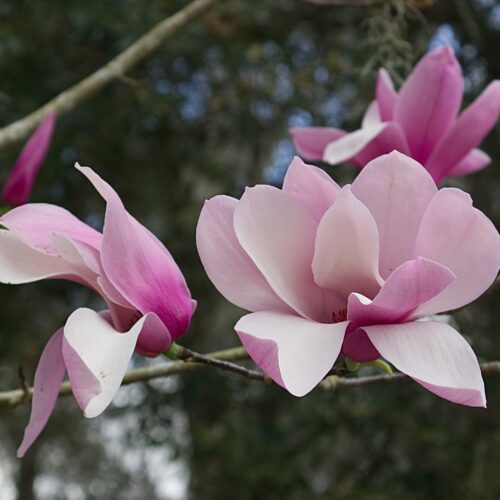How to get that Spring feeling in a garden all summer and beyond!
The first blossoms of the year make us all feel like Spring has finally arrived and add a long-awaited burst of colour and activity to gardens and landscaping. This year, a milder start to the year has seen blossoms appear earlier than usual. In some cases, quite dramatically so – the Caerhays Estate in Cornwall reported Magnolias starting to bloom on the 2nd January! This got us thinking about the timing and use of different blossoming plants and trees throughout the year. In addition to the classic Spring bloomers, what else can be used in garden design and landscaping to keep Spring-like blossoms in the scheme all year round? (Just about!)
Here our favourite late blooming trees that replicate Spring blossom in garden and landscape design:
Late blooming cherry trees
Late blooming cherry trees can offer a delightful extension of the cherry blossom season in the UK. While many cherry trees bloom in early spring, there are a few varieties that bloom later in the season, typically in late spring or even early summer. Whether planted in public parks, botanical gardens, or private gardens, these late-blooming varieties add charm and elegance to the UK landscape:
Sargent Cherry (Prunus sargentii)
The Sargent cherry is a small, deciduous tree native to Japan. It produces clusters of bright pink flowers in late spring, often lasting well into early summer. The blossoms are followed by small red fruits that add visual interest to the tree.
Autumnalis Cherry (Prunus subhirtella ‘Autumnalis’)
As the name suggests, the Autumnalis cherry is known for its late blooming habit, producing flowers intermittently from autumn to spring. This unique flowering pattern allows the tree to bloom both before and after the winter months, providing a welcome burst of colour during the cooler seasons.
Weeping Cherry (Prunus pendula)
Weeping cherry trees, characterised by their graceful, cascading branches, can also bloom later in the season. Varieties such as Prunus pendula ‘Pendula Rosea’ and Prunus pendula ‘Pendula Rubra’ produce delicate pink flowers in late spring or early summer, creating a stunning visual display.
Crab apples
While many crab apple trees bloom in early to mid-spring, there are several varieties that tend to flower later, extending the blossom season. Here are some crab apple varieties that are known for their late blooming habit and are well-suited for the UK climate:
Golden Hornet (Malus ‘Golden Hornet’)
Golden Hornet is a popular crab apple variety valued for its profuse and long-lasting display of white blossoms with a hint of pink. It typically blooms later in the spring, around May, making it one of the later blooming crab apples in the UK. The flowers are followed by small, golden-yellow fruits that persist into winter, providing food for wildlife. Golden Hornet is also prized for its disease resistance and compact, upright growth habit, making it suitable for smaller gardens.
Malus ‘Evereste’
Evereste is a versatile crab apple variety known for its abundant clusters of white flowers tinged with pink. It typically blooms in late spring to early summer, providing a beautiful display that lasts for several weeks. The tree’s glossy green leaves turn shades of orange and red in the autumn, adding further interest to the landscape. Evereste is also valued for its compact size and disease resistance, making it suitable for both ornamental and wildlife-friendly gardens.
Malus ‘Red Sentinel’
Red Sentinel is a late flowering crab apple variety with a profusion of deep pink buds that open to reveal white blossoms with a hint of pink. It blooms in late spring to early summer, often extending the blossom season well into June. The tree’s abundant red fruits persist into winter, providing food for birds and adding colour to the garden. Red Sentinel is also prized for its disease resistance and compact, upright growth habit.
 Late blooming Magnolia
Late blooming Magnolia
Late blooming magnolia varieties offer gardeners in the UK an opportunity to enjoy the beauty of magnolia blossoms for an extended period. Here are some late-blooming magnolia varieties suitable for the UK climate:
Magnolia ‘Yellow Bird’ (Magnolia acuminata ‘Yellow Bird’)
Yellow Bird is a late blooming magnolia variety with large, buttery yellow flowers that appear in late spring to early summer. This cultivar tends to bloom later than many other magnolia varieties, making it less susceptible to damage from late frosts. Its elegant flowers are highly fragrant and add a cheerful pop of colour to the garden. Yellow Bird is also valued for its upright growth habit and tolerance of a wide range of soil conditions.
Magnolia ‘Susan’ (Magnolia liliiflora ‘Susan’)
Susan is a late blooming magnolia variety with deep purple-red flowers that appear in late spring to early summer. This cultivar tends to bloom later than many other magnolia varieties, reducing the risk of frost damage to its blossoms. Susan’s fragrant flowers attract bees and butterflies, adding a touch of beauty and biodiversity to the garden. This variety is also valued for its compact size and disease resistance.
Magnolia ‘Leonard Messel’ (Magnolia x loebneri ‘Leonard Messel’)
Leonard Messel is a late-flowering magnolia variety with delicate, star-shaped flowers in shades of pale pink and white. It typically blooms in late spring to early summer, extending the blossom season well into June. This cultivar is known for its tolerance of cooler temperatures and is less susceptible to damage from late frosts. Leonard Messel’s elegant flowers create a stunning display in the garden and attract pollinators.
For further inspiration on late bloomers, we recommend a visit to RHS Wisley which has a broad range of late blooming trees in their varied gardens.
We’d love to hear about any plants or trees you use to add late blossoms to a scheme, or help you source late blooming trees for your next project. Contact us at enquiries@thebiggreenplantcentre.co.uk 01895 834834.

Recent Comments